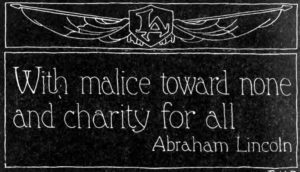
On the morning of April 15th, 1865 the nation woke to the news of the death of Abraham Lincoln, who had been shot the night before. The 16th President, who had led the country through the bloodiest war in American history, had issued the Emancipation Proclamation and given the Gettysburg Address was dead.
A little more than a month before, Lincoln had given his second inaugural address. His words would place no blame for the war but sought to heal a country deeply wounded and to let the world know that America was once again a nation united.
“With malice toward none, with charity for all, with firmness in the right as God gives us to see the right, let us strive on to finish the work we are in, to bind up the nation’s wounds, to care for him who shall have borne the battle and for his widow and his orphan, to do all which may achieve and cherish a just and lasting peace among ourselves and with all nations.”
In 1865, what we now know as the state of Nebraska was only a territory. After receiving statehood later that year, it was decided to move the capital from Omaha to Lancaster which was renamed Lincoln, in honor of the slain president.
Fast forward to 1947, when much of Europe laid in ruin after of the Second World War. The American journalist, Drew Pierson, had recently returned from an overseas visit where he saw communist countries being praised for giving food aid to France and Italy.
Pierson knew that winning the war was one thing, but winning the peace was quite another. The war had been fought to free people from tyranny, but if people in Europe were starving, communism might be the preferred evil.
Pierson came up with the idea of a freight train, one that would cross the entire US, picking up donations of food which would then be sent Europe. Using his nationally syndicated newspaper column as a platform he pleaded with newspapers across the country to take up this cause – and they did. The American people rallied to help those who were hungry in France and Italy.
On November 7th, 1947 a train loaded with wheat, dry milk, flour, and other food left Los Angeles, CA on a trip that would take it to Bakersfield, Fresno, Merced, Stockton, Oakland, Sacramento (California), Reno (Nevada), Ogden(Utah), Green River, Rawlins, Laramie, Cheyenne (Wyoming), Sidney, North Platte, Kearney, Grand Island, Fremont, Omaha (Nebraska), Council Bluffs, Boone, Ames, Cedar Rapids, Clinton (Iowa), Sterling, and Chicago (Illinois). From Chicago, the main route passed through Fort Wayne (Indiana), Mansfield (Ohio), Pittsburgh, Altoona, Harrisburg, Lancaster, Philadelphia (Pennsylvania), and Trenton (New Jersey) before reaching New York City where a ticker tape parade was held.
The Friendship Train, as it was called, would cross the US, but didn’t stop at every city. When the residents of Lincoln, Nebraska learned that theirs was one city that it would miss, they decided to send their own train.
On Lincoln’s birthday in 1948, the train named the Abraham Lincoln Friendship Train launched from Lincoln, Nebraska with carloads of food donated by the local residents and residents of Colorado and Wyoming. More donations were picked up in Iowa, South Dakota and Illinois before arriving in New York where the supplies were loaded on a ship and sent on to Europe.
You can watch a short black and white film about the Friendship Train on Turner Classic Movies.
